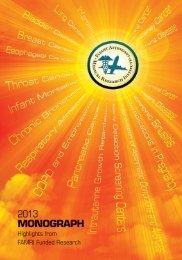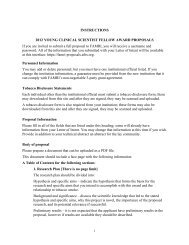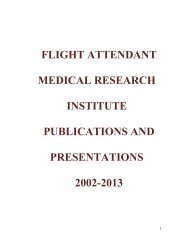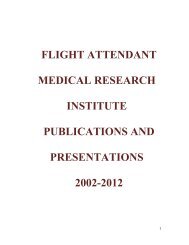MISSION
2009 compendium of FAMRI-supported research - Flight Attendant ...
2009 compendium of FAMRI-supported research - Flight Attendant ...
Create successful ePaper yourself
Turn your PDF publications into a flip-book with our unique Google optimized e-Paper software.
Presented at the Annual Meeting of the American Association for Cancer Research, April 2006.<br />
Zhou W, Heist RS, Liu G, Neuberg DS, Asomaning K, Su L, Wain JC, Lynch TJ, Giovannucci E,<br />
Christiani DC. Polymorphisms of vitamin D receptor and survival in early-stage non-small cell lung<br />
cancer patients. Cancer Epidemiol Biomarkers Prev 2006;15:2239-45.<br />
Zhou W, Heist RS, Liu G, Park S, Neuberg DS, Asomaning K, Wain JC, Lynch TJ, Christiani DC.<br />
Smoking cessation before diagnosis and survival in early stage non-small cell lung cancer patients. Lung<br />
Cancer 2006;53:375-80.<br />
Zhou W, Liu G, Park S, Wang Z, Wain JC, Lynch TJ, Su L, Christiani DC. Gene-smoking interaction<br />
associations for the ERCC1 polymorphisms in the risk of lung cancer. Cancer Epidemiol Biomarkers Prev<br />
2005;14:491-496.<br />
Zhou W, Park S, Liu G, Miller DP, Wang LI, Pothier L, Wain JC, Lynch TJ, Giovannucci E, Christiani<br />
DC. Dietary iron, zinc, and calcium and the risk of lung cancer. Epidemiology 2005;16:772-779.<br />
Zhou W, Suk R, Liu G, Park S, Neuberg DS, Wain JC, Lynch TJ, Giovannucci E, Christiani DC. Vitamin<br />
D is associated with improved survival in early-stage non-small cell lung cancer patients. Cancer<br />
Epidemiol Biomarkers Prev 2005;14:2303-2309.<br />
THE ROLE OF THE TRANSCRIPTION FACTOR C/EBP ALPHA IN NORMAL LUNG DEVELOPMENT AND IN MURINE<br />
MODELS OF LUNG CANCER AND TOBACCO-DAMAGED AIRWAY EPITHELIUM<br />
Elena Levantini, PhD; Harvard University; YCSA 2006<br />
Lung cancer is the principal cause of worldwide cancer mortality. Advances in lung cancer therapy<br />
require a greater understanding of its molecular pathogenesis. Previously, Dr. Levantini showed that the<br />
transcription factor CCAAT/enhancer binding protein alpha (C/EBPa) is downregulated in NSCLC<br />
patients. Furthermore, using a mouse model where excision of C/EBPa is under the control of the<br />
Surfactant Protein C (SPC) promoter (C/EBPa SPC-deleted) mice, Dr. Levantini showed that this<br />
transcription factor regulates alveolar type II cell differentiation. Subsequently she investigated the effects<br />
of C/EBPa downregulation in predisposing the mouse lung epithelium to tumorigenesis and<br />
demonstrated that the C/EBPa SPC-deleted mouse lung epithelium displays increased numbers of<br />
proliferating cells and decreased numbers of apoptotic cells. The PI also identified potential target genes<br />
that may elucidate the mechanisms by which C/EBPa acts. For example, the cell survival gene Gli-1, a<br />
transcription factor downstream of sonic hedgehog signaling, is upregulated and its contribution in<br />
promoting the malignant phenotype promises to be important biologically and therapeutically. Therefore,<br />
Dr Levantini and collaborators hypothesized that loss of C/EBPa in the adult lung epithelium is a<br />
transforming event. Consistently, their data indicate that C/EBPa is detected at the level of<br />
bronchoalveolar stem cells, a pulmonary population that has been recently linked to adenocarcinoma<br />
initiation. Moreover, Dr Levantini has data from two different lung conditional models [SPC and Clara<br />
Cell (CC10)-driven excision] that supports her hypothesis that C/EBPa is a lung tumor suppressor, in that<br />
they develop adenocarcinoma. Furthermore, their data indicate that Gli-1, a transcriptional effector of the<br />
sonic hedgehog pathway, is highly active only in C/EBPa-deleted pulmonary cells that, according to her<br />
hypothesis, represent the cells of origin of the lung adenocarcinomas found in her murine models. Gli-1<br />
expression peaks in the lung stem cells, it is reduced in progenitor cells, but it is still active in the<br />
adenocarcinoma. Overall, Dr Levantini’s data show that loss of C/EBPa might increase the susceptibility<br />
to lung cancer development and supports the hypothesis that C/EBPa acts as a tumor suppressor for lung<br />
cancer in vivo.<br />
FAMRI Supported Publications<br />
Basseres D, Levantini E, Ji H, Monti S, Elf S, Dayaram T, Fenyus M, Kocher O, Golub T, Wong KK,<br />
Halmos B, Tenen DG. Respiratory failure due to differentiation arrest and expansion of alveolar cells<br />
following lung-specific loss of the transcription factor C/EBP-alpha in mice. Mol Cell Biol<br />
2006;26:1109- 1123.<br />
Koschmieder S, D’Alo F, Radomska H, Schoneich C, Chang JS, Konopleva M, Kobayashi S, Levantini E,<br />
Suh N, DiRuscio A, Voso MT, Watt JC, Santhanam R, Sargin B, Kantarijan H, Andreeff M, Sporn MB,<br />
Perrotti D, Berdel WE, Muller-Tidow C, Serve H, Tenen DG. CDDO induces granulocytic<br />
differentiation of myeloid leukemic blasts through translational upregulation of p42 CCAAT enhancer<br />
binding protein alpha. Blood 2007; 110(10):3695-705.<br />
Koschmieder S, Halmos B, Levantini E, Tenen DG. Dysregulation of the C/EBPa differentiation pathway<br />
in human cancer. Journal Clinical Oncology 2009;27(4):619-28.<br />
Kubo S, Levantini E., Kobayashi S, Kocher O, Halmos B, Tenen DG, Takahashi M. In vitro three-<br />
P A G E 1 1 1







